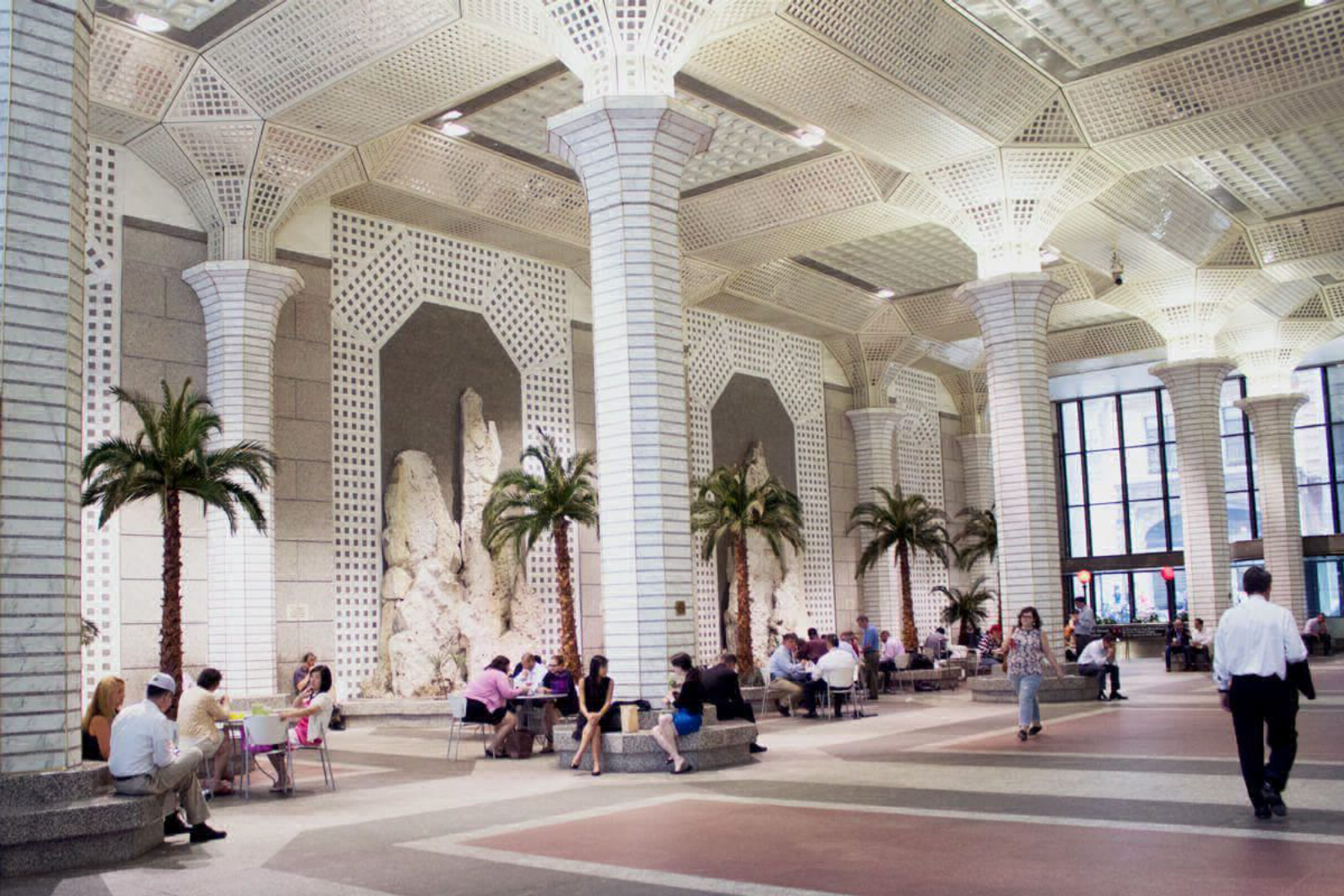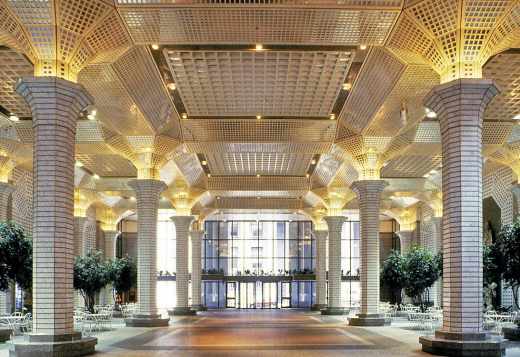Background
60 Wall Street (formerly the J.P. Morgan Bank Building or Deutsche Bank Building) was completed in 1989 by Kevin Roche, John Dinkeloo and Associates. This postmodern office tower design is bold in form and daring in its execution, borrowing many elements from classical architecture. The building boasts an atrium that is perhaps one of the most unique spaces in all of New York City. As described by Benjamin Kellogg in an article earlier this year, "the style of this interior alludes to Mughal design: it’s a winter garden with flowering octagonal columns supporting mirrored ceilings framed with white trelliswork, inducing a reflective kaleidoscopic effect that Roche has been known to utilize." The atrium is a "POPS," a privately-owned public space, and also has a subway entrance inside it. Read a full description of the POPS on the Municipal Art Society website.
Update: November 10, 2023
On October 16th, advocates for the preservation of 60 Wall Street issued a joint letter to the the Landmarks Preservation Commission and Department of City Planning expressing serious concern regarding the management of the proposed modifications to the 60 Wall Street POPS. The letter (that can be found here) argues the proposed modifications "are more accurately described as a gut renovation than as any sort of modification, and would definitively remove the elements that have given this space its distinctive identity for nearly forty years and in our view justify its landmarking." The letter goes on to summarize a list of five objections ahead of the demolition of this public space.
As of this update, we are aware of a demolition permit approved by the Department of Buildings for the removal of the interior finishes in the public space. Docomomo US along with our fellow advocates continue to seek ways in which to stop this destruction of this space.
Update: August 31, 2023
In response to a letter by Council Member Marte asking the Landmarks Preservation Commission and Department of City Planning to work together to "save this iconic and beloved public space", the LPC stated the agency, "will not prioritize further study of the interior space." Continuing in the letter Chair Carroll states:
The transit and other public benefits connected to this POPS create critically important infrastructure for the city and require flexibility to meet future needs, and rigorous coordination between the Department of City Planning and the applicant. To preserve and enhance the significant public benefits of the POPS in accordance with the original special permit, and in support of larger citywide priorities including economic revitalization, it may be necessary to alter the interior design of the POPS.
It is important to understand that the Landmarks Law requires that a building be at least 30 years old to be designated as an individual landmark and that 60 Wall Street reached this benchmark only a few years ago. Because Postmodern architecture has only recently reached the age of eligibility for consideration as landmarks, the Commission needs to fully understand the significance of the era and the relative merits of individual buildings. I also note that interior designations are extremely rare; of the nearly 38,000 designated buildings and sites in New York City, LPC has only designated 121 interior landmarks across all five boroughs.
One business day later and without public notice, the City Planning Commmision held a hearing approving the proposed changes to the interior POPS. At the hearing, the planning commission’s chair Dan Garodnick acknowledged the lobby’s architectural merits but said the ruling ultimately came down to a cut-and-dry private property issue. “Like many members of the public, I have a certain amount of fondness for the existing design of 60 Wall Street,” Garodnick stated. “That said, it’s not a landmarked interior, and the owners have a right to update, refresh and reposition this vacant commercial office building.”
At this time, Docomomo US and the advocates for 60 Wall Street intend to regroup and appeal the decision by City Planning. Noted architect Robert A.M. Stern championed 60 Wall and its lobby. Stern, and award winning architecture critic Paul Goldberger, powerfully rebutted LPC’s reasoning in a letter to the LPC Chair.
Recent news coverage:
"The Final Days of Wall Street’s Beloved ‘Tacky’ ’80s Lobby," The New York Times, August 31, 2023.
"Alexandra Lange, Robert A.M. Stern, Docomomo, and Preservation Futures on the fate of 60 Wall Street’s lobby," The Architect's Newspaper, August 31, 2023.
Update: July 11, 2023
Advocates provided statements to the Housing, Land Use and Zoning Committee of Community Board 1 Manhattan on Monday night against the proposed alterations to the public interior at 60 Wall Street. The proposal can be found here. After a marathon three-hour summer meeting, the community board voted NOT to approve the proposal with conditions. Conditions included waiting until the NYC Landmarks Preservation Commission makes a final determination on designation for the property. While the Department of City Planning can ignore this recommendation, we are hopeful this will not be the case due to strong opposition by Councilmember Marte and considerable public use concerns with the current proposal. Advocates are asked to provide testimony to the July 25th full MCB1 meeting.
Update: June 8, 2023
The New York City Department of City Planning will review the proposed modification application soon. More information to follow.
Update: March 6, 2023
Advocates for the designation of 60 Wall Street will meet in the POPS space at 60 Wall Street at 11AM to urge the New York City Landmarks Preservation Commission to designate 60 Wall Street as an individual and interior landmark. This comes on the heels of the January 2023 vote by the Commission to allow the developer to make only modest changes to the exterior essentially preserving the iconic colonnade and the essential nature of the building. The LPC previously noted "the building and interior POPS merit further study within the context of Postmodern commercial architecture and interiors."
Read the coalition letter to the Landmarks Preservation Commission.
If you would like to add your name to the letter, email us at info@docomomo-us.org. You may also email Sarah Carroll, Chair of the Landmarks Preservation Commission here.
Initial signories of the letter include:
Docomomo US
Historic Districts Council
Manhattan Community Board 1
New York City Council Member Christopher Marte (District 1)
New York State Assemblymember Grace Lee (District 65)
New York State Senator Brian Kavanagh (District 27)
Human Scale NYC
Municipal Art Society
New York Landmarks Conservancy
Preservation League of New York State
The Paul Rudolph Institute for Modern Architecture
Tribeca Trust
Deborah Berke
Alice Blank
Adam Nathaniel Furman
Paul Goldberger
Rock Herzog (Cocaine Decor)
Alexandra Lange
Eeva-Liisa Pelkonen
Robert A.M. Stern
Other individuals (calling on immediate designation):
Kyle Johnson, AIANY tour guide
Brian D. Goldstein, Assoc. Prof. Arch. History Swarthmore
Linda Scinto, Archivist, KRJDA
Stephen Magner
Kathy L. Heard
Carol Herselle Krinsky, Architectural Historian NYU, President Society of Architectural Historians
Cynthia Toles
Ward Miller, Executive Director of Preservation Chicago
Tim Hayduk, Lead Design Educator, Center for Architecture NY
Fernando Diniz Moreira, Chair Docomomo Brazil, Professor of Architecture
Warren James, Warren A. James Architecture and Planning
Martha Frish
Update: February 7, 2023
The developers of 60 Wall Street were back at the NYC Landmarks Preservation Commission (LPC) on Tuesday, January 31st with a third proposal for façade alterations. In a surprising turn of events, the proposal no longer sought to destroy the iconic Postmodern chamfered colonnade and instead recognized that the current design is the only one that keeps the harmonious relationship with 55 Wall across the street. The proposal however included modifications to the recessed inner wall. The Commissioners said this area does not stand out and the overall effect is a variation on the original design that could be landmark-worthy.
Docomomo US and our colleagues at Historic Districts Council, Council Member Christopher Marte and Community Board 1 Manhattan provided written feedback on the changes that were passed by the Commission unanimously. With the essential character of the building’s exterior saved, our coalition feels strongly that the LPC must move forward on the designation of 60 Wall Street. The façade presentation drawings clearly show the interior privately owned public space (POPS) gutted. The approved facade proposal to open up and bring more light and transparency into the public space will only strengthen the visual relationship of the interior to the exterior design and we insist the interior be protected in a similar fashion to the exterior.
In the coming days, the coalition will release a letter and public campaign to designate 60 Wall Street as a New York City landmark and interior landmark.
Update: September 20, 2022
Today, in an exciting win for preservationists, a majority of commissioners of the New York City Landmarks Preservation Commission (LPC) rejected a revised proposal for changes to the exterior base of the Kevin Roche-designed 60 Wall Street. We are pleased with the findings by the LPC that the proposal was not harmonious, that the current building is more harmonious, and that the process to review the exterior and interior needs to be completed. There is enough research, based on the Ambassador Grill & Lobby (also by Roche Dinkeloo) and the Philip Johnson-designed AT&T Building, to support exterior and interior landmark designation for 60 Wall. The building retains a high level of integrity and the design and materials are of exceptional quality.
Our efforts for this project are far from over. The decision today does not protect the building in any way and the commission did not agree to calendar either an exterior or interior landmarking request.
Recent news coverage:
"A Win for Activists Fighting to Save 'Wonderful and Weird' Wall St. Atrium," Tribeca Trib, September 27, 2022.
"60 Wall Street’s Lobby Is Weird and Ridiculous and Deserves to Be Saved," Curbed, September 19, 2022.
"The Fight to Save New York’s Extravagantly ’80s Subway Entrance," The New York Times, July 29, 2022.
"An Iconic Postmodern New York Lobby Is Slated for Destruction—Can It Be Saved?" Cultured, January 12, 2022.
Support our continued work to landmark this significant Postmodern site by making a donation today.
















